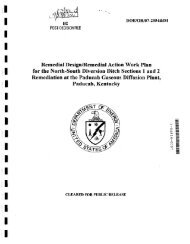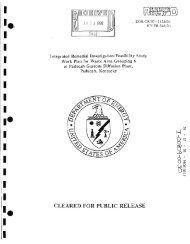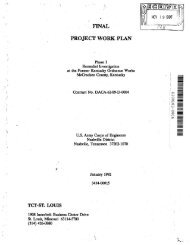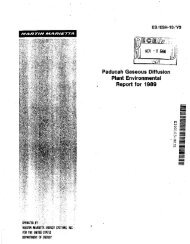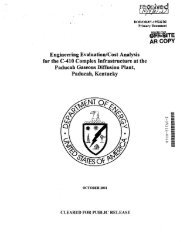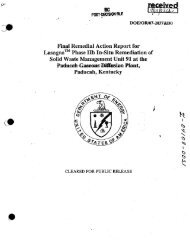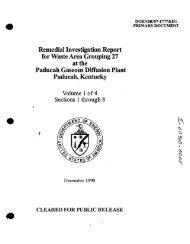1 - paducah environmental information center
1 - paducah environmental information center
1 - paducah environmental information center
You also want an ePaper? Increase the reach of your titles
YUMPU automatically turns print PDFs into web optimized ePapers that Google loves.
Paducah Site<br />
Additional data is provided in Appendix C.<br />
Direct Radiation<br />
locations were consistently above background<br />
levels (BJC 2000b). These locations were all at<br />
or near the POOP security fence in the vicinity of<br />
VF6 cylinder storage yards (Figures 5.4 and 5.5).<br />
A primary pathway of concern for DOE's<br />
operations at ,the Paducah Site is direct external<br />
radiation exposure. External radiation exposure<br />
is defmedas exposure attributed . to radioactive<br />
sources outside the body (e.g., cosmic gamma<br />
radiation)~ . Sources' of external radiation<br />
exposure from the Paduclih Site include cylinder<br />
storage yards, the cascade system, and small<br />
sources such as instrument check locations.<br />
Cylinder storage yards have the largest potential<br />
fora dose to the public. because of their<br />
proximity .to the' POOP security fence.<br />
The Paducah Site Environmental<br />
Monitoring Plan (BJC 1998) establishes DOE's<br />
program for monitoring extermd gamma<br />
radiation at areas accessible to members of the<br />
public. The external radiatiQn ~xposure<br />
monitoring prograni has the foliowing three<br />
objectives:<br />
Annual dose rates for the background<br />
locations and .the three locations above<br />
background were calculated. The mean annual<br />
background exposure was determined to .be 99<br />
rnrem. For each location, the mean background<br />
exposure was subtracted from the annualized<br />
total exposure to obtain a net annual exposure.<br />
The net animal exposure represents the total<br />
exposure at that location, for the entire calendar<br />
year 1999, attributed to the Paducah Site (Table<br />
5.8). All exposure measured at these locations is<br />
assumed to result from DOE operations, Dose<br />
from direct radiation exposure is discussed in<br />
Section 6.<br />
Additional data is provided in Appendix C.<br />
• to establish the. potential radiation<br />
dose received by a member of the public<br />
from direct· exposure to DOE operations<br />
at the boundary ot the DOE perimeter<br />
fence,<br />
-.<br />
. to;. establish the potential dose a<br />
member of the public .may receive<br />
visitin~ or passing .. through accessible<br />
portions of the DOE reservatiOli, and<br />
. .:<br />
I·<br />
I<br />
• .' to calculate the radiation dose<br />
equivalent to the maximally exposed<br />
individual member of the public.<br />
, In 1999, monitoring consisted of quarterly<br />
placement, collection, and analysis' of<br />
<strong>environmental</strong> thermolumiIiescent dosimeters<br />
(TLDs). Monitoring results indicate that four<br />
5·8<br />
Radiological Environmental Surveillance



